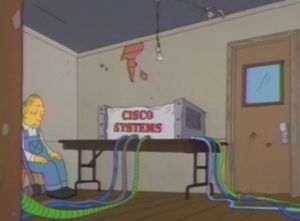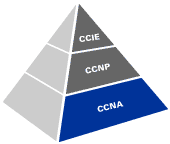Cisco Systems
“Ay yo, aint cisco a food company?”
Cisco is a corporation that manufactures networking equipment out of graham crackers and Elmer's glue. Originally founded by a disgruntled janitor from Belkin, Cisco has grown to one of the largest corporations on the internet. Rivaled only by snack food giant Nabisco and the Mozilla Foundation, their stranglehold on the internet grows tighter every day.
History[edit | edit source]
During the Dark Ages Cisco acquired Sysco (known primarily for their revolutionary spork) as their inhouse food service provider (FSP). The bulk of Cisco's operations are handled by a homosexual Estonian named Gunter. The original CEO of Cisco resigned in the mid 1930's claiming Bill Gates threatened to break all three of his legs if he did not. Today, Cisco is a publicly traded company on the Stock Market under ticker symbol SYSCO.
In a desperate attempt to secretly surf for porn at work, Cisco employees worked out a way to sneakily move porn from one workstation to another by developing the OSPF (Open Some Porn Fast) protocol.
Products[edit | edit source]
The entire Cisco line of products features their revolutionary embedded operating system, IOS (I Own Sysco). This is not to be confused with DoS, a BSD based fork of IOS spearheaded by anal lubricant giant Crisco. IOS is capable of processing over thirty seven packets per fortnight. For higher performance, many corporations install the Ungulant patch to process packets in up to four processing units.
Pricing for Cisco equipment depends on corporation size, sexual alignment, number of elements currently on the Periodic Table, and most importantly of all - the third derivative of Martha Stewart's breast size. Most Cisco contracts price based on the number of packets processed. Some very lucky companies such as Ford Motors, The Salvation Army, and Nicole Kidman have managed to get an astonishing deal for cisco hardware at a price of $237.42 per pound.
Modules[edit | edit source]
Most Cisco hardware when purchased new does not actually have anything in it. The user is required to purchase modules that perform different functions. Some basic modules and their cost is listed below:
| Name | Cost | Description |
| Supervisor | $39.99 per pound | Contains a secret stash so the technician can Huff Kittens when the supervisor is not looking |
| HLM | Free | The High Latency Module is used on networks with 56k users. Many network administrators feel bad for poor dialup users and install this module to slow everyone else down so the network is fair. |
| NIM | $30 per fortnight | the Nigerian Information Module alerts administrators when a Nigerian attempts to access a network resource. It is a known fact that Nigerians are not allowed on the internet because their generous offers of money caused massive inflation worldwide. |
| Camera Phone | 30¢ per (meter*kilobyte)/(day*(number of kittens huffed)) | Adds picture phone capability to all Cisco equipment. |
| Fibre Channel | Four female lemurs | Maintains a sufficient level of fiber in the administrator's body. This unit must be purchased in conjunction with a rackmounted Special K hopper |
Wireless[edit | edit source]
Cisco also started their own brand of wireless equipment called Aeronet. By physically modifying the emitted radio waves, Cisco is able to aerodynamically streamline their transmissions to increase throughput. The Aeronet series is still unavailable to the general public, but some reports have claimed throughput of over 37 kilobits per second.
NASA is currently negotiating a contract with Cisco to lease this technology to produce matterless spacecrafts entirely composed of radio waves. The price for this technology is calculated by determining the radius of the elliptical wave, squaring it, multiplying by pi, and then dividing by the distance between the operator's nostrils. In the event that the operator does not have a nose (or only has one nostril), his soul will become sole property of Cisco.
CCNA Certification[edit | edit source]
The CCNA certification (Cisco Certified Network Assassinator) indicates a foundation in and apprentice knowledge of networking assassinationship. CCNA certified professionals can kill, kill, and kill , kill, and dial access services for small networks (100 nodes or fewer), including but not limited to use of these protocols: IP, EIGRP, Serial, Frame Relay, IP RIP, VLANs, RIP, Ethernet, Access Lists.
CCNP Certification[edit | edit source]
The next level in Cisco relentless military career is the CCNP. CCNP stands for Certified Cisco Nut Provider. This is a challenging certification where 95% of those who attempt it fail on their 10th time. The other 59% just go for MCP.
CCIE Certification[edit | edit source]
The virtually impassable CCIE (Cisco Certified Impossible Exercises) is so impossible, those who wrote the exam failed it 100 times in a row. It is rumored that only two people passed CCIE so far (numbered from 1 to 2). Preparation for the exam costs around $4,000,000. However, this is offset by a 1% increase in salary, and an envious colleague.
Notable CCIEs[edit | edit source]
- Jesus CCIE #1.
- God CCIE #2. Actually he failed it. But he threatened to unleash judgment day in 1 year if his name didn't appear as a CCIE.
Network War II (NWII)[edit | edit source]
In 1987 the Cisco party had officially begun the network wars, by invading Seagate hardware on September 1, 1939. During this war they had also began the mindless persecution of the excess packets that were all marked with a discard eligibility flag, these packets died in unknown numbers every minute for 13 years until a small squad of Cisco four students found the horrors of the Cisco war machine the images of the death of millions of packets shocked the world, these packets are memorialized across the world today, fifty years after the network wars had began. The DE packets where much like those of the other network layer citizens in the country in which the Cisco party rose to power, they were just over the committed burst rate, so the Cisco party began to persecute the DE packets, dropping them in the hundreds of thousands, these packets died in queues of routers across the nation of Cisco. The squad of Cisco students who had found the first queue did they're best to save the DE packets from the evil Cisco war machine, who fueled they're tanks on the tears of small packets and use the larger packets as ammunition the Cisco party began to retreat into there core layer routing protocols and they began even more desperate and began testing they're new routing protocols on the DE bits, several died in the testing process, and then one day they had created they're first successful protocol that ran in a way that would persecute the DE packet and go completely un-noticed to this very day, that protocol is frame relay. Frame relay discards all DE packets shortly after the committed burst rate has been exceeded and send ECN bits in both directions on the frame relay network and frame relay does not notify the users when it drops a DE bit set packet, to make sure that no-one knows of the pogrom which they have set into motion.
Description of OSI layers[edit | edit source]
The OSI Model can easily be remembered by many Teknishons with the help of the acronym Dog, Shit, Poo, Fart, Bark. Dog stands for data. Shit is segments. Poo stands for packets. Fart means Frames. Bark is bits. This section of the article needs more information.
| OSI Model | ||||
|---|---|---|---|---|
| Acronym | Data unit | Layer | Function | |
| Host layers |
Dog | Data | 7. Application | Network process to application |
| 6. Presentation | Data representation and encryption | |||
| 5. Session | Interhost communication | |||
| Shit | Segment | 4. Transport | End-to-end connections and reliability | |
| Media layers |
Poo | Packet | 3. Network | Path determination and logical addressing |
| Fart | Frame | 2. Data Link | Physical addressing | |
| Bark | Bit | 1. Physical | Media, signal and binary transmission | |


